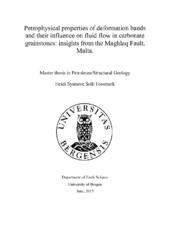| dc.description.abstract | Deformation bands are tabular, sub- centimeter thick zones, which accommodates shear and/or volumetric deformation. Only a few examples of deformation bands have been documented in porous carbonate rocks, and the knowledge about how petrophysical properties and fluid flow interacts in such settings is thus limited. Motivated by this, the current study focus on deformation bands found in carbonate grainstones in the hangingwall of an extensional fault on the southwestern coast of Malta, the Maghlaq Fault, in an attempt to elucidate their petrophysical properties and their dynamic effect on fluid flow by means of reservoir modeling and flow simulations. The studied deformation bands are hosted in the porous Globigerina Limestone Formation, where structural data were recorded along deformation band frequency scanlines to characterize the bands and their spatial distribution. Moreover, porosity and permeability were determined for both host rock and deformation bands using gas-transfer techniques and image analysis. By applying an inflated modeling approach, deformation bands are represented by semi-discrete means, closely reproducing the observed spatial distribution pattern and structural geometries. Flow simulations of the inflated models, where deformation band permeability is the main variable tested, are compared to a reference case where deformation bands are absent. The results from the flow simulation show that increasing permeability contrast between host rock and deformation bands causes fluid flow complexity, reflected by variations in the shape and propagation speed of the waterfronts from the injection wells. In turn, slow water front propagation results in delayed water break-through in the production wells. With low initial host rock permeability, deformation bands have an effect on fluid flow even when the contrast of permeability between them and host rock is 1 order of magnitude. Alternatively, with high initial host rock permeability, the permeability contrast needs to be 2 orders of magnitude, or more, to significantly affect fluid flow across the grid. The results of the present study demonstrate that the inflated modeling approach is well suited to capture details of flow in the presence of small- scale flow baffles. Understanding how geological heterogeneity and fluid flow interacts in reservoirs is important for the prediction of flow and optimization of production strategies. Thus, the modeling approach presented herein can improve the incorporation of small- scale features into conventional sized reservoir models. | en_US |
